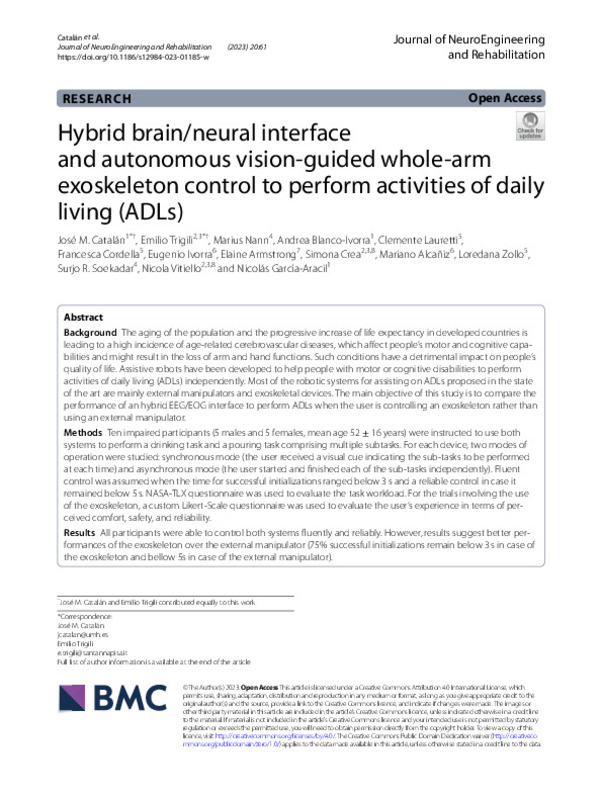Catalán, JM.; Trigili, E.; Nann, M.; Blanco-Ivorra, A.; Lauretti, C.; Cordella, F.; Ivorra, E.... (2023). Hybrid brain/neural interface and autonomous vision-guided whole-arm exoskeleton control to perform activities of daily living (ADLs). Journal of NeuroEngineering and Rehabilitation. 20(1):1-16. https://doi.org/10.1186/s12984-023-01185-w
Por favor, use este identificador para citar o enlazar este ítem: http://hdl.handle.net/10251/201631
|
Título:
|
Hybrid brain/neural interface and autonomous vision-guided whole-arm exoskeleton control to perform activities of daily living (ADLs)
|
|
Autor:
|
Catalán, José M.
Trigili,Emilio
Nann, Marius
Blanco-Ivorra, Andrea
Lauretti, Clemente
Cordella, Francesca

 Ivorra, Eugenio
Elaine Armstrong
Crea, Simona
Ivorra, Eugenio
Elaine Armstrong
Crea, Simona

 Alcañiz Raya, Mariano Luis
Zollo, Loredana
Soekadar, Surjo R.
Vitiello, Nicola
Garcia-Aracil, Nicolás
Alcañiz Raya, Mariano Luis
Zollo, Loredana
Soekadar, Surjo R.
Vitiello, Nicola
Garcia-Aracil, Nicolás
|
|
Entidad UPV:
|
Universitat Politècnica de València. Escuela Técnica Superior de Ingeniería Agronómica y del Medio Natural - Escola Tècnica Superior d'Enginyeria Agronòmica i del Medi Natural
Universitat Politècnica de València. Escuela Técnica Superior de Ingeniería del Diseño - Escola Tècnica Superior d'Enginyeria del Disseny
|
|
Fecha difusión:
|
|
|
Resumen:
|
[EN] Background
The aging of the population and the progressive increase of life expectancy in developed countries is leading to a high incidence of age-related cerebrovascular diseases, which affect people's motor and ...[+]
[EN] Background
The aging of the population and the progressive increase of life expectancy in developed countries is leading to a high incidence of age-related cerebrovascular diseases, which affect people's motor and cognitive capabilities and might result in the loss of arm and hand functions. Such conditions have a detrimental impact on people's quality of life. Assistive robots have been developed to help people with motor or cognitive disabilities to perform activities of daily living (ADLs) independently. Most of the robotic systems for assisting on ADLs proposed in the state of the art are mainly external manipulators and exoskeletal devices. The main objective of this study is to compare the performance of an hybrid EEG/EOG interface to perform ADLs when the user is controlling an exoskeleton rather than using an external manipulator.
Methods
Ten impaired participants (5 males and 5 females, mean age 52 +/- 16 years) were instructed to use both systems to perform a drinking task and a pouring task comprising multiple subtasks. For each device, two modes of operation were studied: synchronous mode (the user received a visual cue indicating the sub-tasks to be performed at each time) and asynchronous mode (the user started and finished each of the sub-tasks independently). Fluent control was assumed when the time for successful initializations ranged below 3 s and a reliable control in case it remained below 5 s. NASA-TLX questionnaire was used to evaluate the task workload. For the trials involving the use of the exoskeleton, a custom Likert-Scale questionnaire was used to evaluate the user's experience in terms of perceived comfort, safety, and reliability.
Results
All participants were able to control both systems fluently and reliably. However, results suggest better performances of the exoskeleton over the external manipulator (75% successful initializations remain below 3 s in case of the exoskeleton and bellow 5s in case of the external manipulator).
Conclusions
Although the results of our study in terms of fluency and reliability of EEG control suggest better performances of the exoskeleton over the external manipulator, such results cannot be considered conclusive, due to the heterogeneity of the population under test and the relatively limited number of participants.
[-]
|
|
Palabras clave:
|
Assistive robotics
,
Brain injury
,
Brain-machine interface
,
Multimodal system
,
Spinal-cord injury
,
User intention prediction
|
|
Derechos de uso:
|
Reconocimiento (by)
|
|
Fuente:
|
Journal of NeuroEngineering and Rehabilitation. (issn:
1743-0003
)
|
|
DOI:
|
10.1186/s12984-023-01185-w
|
|
Editorial:
|
Springer (Biomed Central Ltd.)
|
|
Versión del editor:
|
https://doi.org/10.1186/s12984-023-01185-w
|
|
Código del Proyecto:
|
info:eu-repo/grantAgreement/AEI/Plan Estatal de Investigación Científica y Técnica y de Innovación 2017-2020/PID2019-108310RB-I00/ES/NOVEDOSOS SISTEMAS ROBOTICOS DE REHABILITACION AUTOADAPTATIVOS Y MULTIMODALES EN ENTORNOS DE APOYO CONTROLADOS/
info:eu-repo/grantAgreement/EC/H2020/645322/EU/Adaptive Multimodal Interfaces to Assist Disabled People in Daily Activities/AIDE/
info:eu-repo/grantAgreement/AEI/Plan Estatal de Investigación Científica y Técnica y de Innovación 2021-2023/PLEC2022-009424/ES/Interfaces multimodales cerebro -máquina para uso doméstico independiente a largo plazo en actividades de la vida diaria complejas./
|
|
Agradecimientos:
|
This study was funded by the European Commission under the project AIDE (G.A. no: 645322), Spanish Ministry of Science and Innovation, through the projects PID2019-108310RB-I00 and PLEC2022-009424 and by the Ministry of ...[+]
This study was funded by the European Commission under the project AIDE (G.A. no: 645322), Spanish Ministry of Science and Innovation, through the projects PID2019-108310RB-I00 and PLEC2022-009424 and by the Ministry of Universities and European Union, "fnanced by European Union-Next Generation EU" through Margarita Salas grant for the training of young doctors.
[-]
|
|
Tipo:
|
Artículo
|









